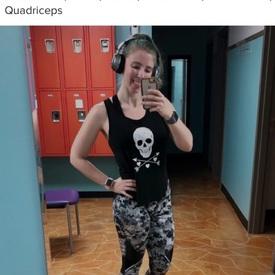Low income grocery shopping tips for a newbie to adult crap.

madxprofessor
Posts: 81 Member
So I am 22 and been on my own for 2 years, but i find myself running out of food money and having my dad bring me pizzas and fast food because that is all he will buy me even though i'm trying to lose weight.... Anyways I need good advice on how to make roughly $350 last a whole month if that's even possible. I love fresh fruit and veg but can only get 2 shopping trips in a month currently, leaving plenty of time for the end of my 2 weeks worth of fresh stuff to go to waste. I am okay with frozen vegetables but not frozen fruit. I am only cooking for 2 people 3 times a day including myself. I need no-so-obvious tips on how to stretch my money like its the great depression. thanks in advance if you read all that. 
0
Replies
-
i shop for 3 and my budget is 180 to 200 if that. i always check for sales. sometimes you can also get food from the dollar tree, 99 cent store. cut up your fruits and veggies. take fruit with you everyday. dont shop "namebrand" store brand is the same and much cheaper.if your going to freeze ur fruit only use for smoothies if you make them. the pizza your dad brings, he could give you the money to BUY healthy foods until you get more money. tell him that you want healthy items. i wish i could spend 350 on groceries. ohwell i do what i can. im low on food, but i make it work. meat and veggies.0
-
Shop at discount grocery stores like Aldi's.
I can get a small bag of sweet potatoes for $2. Banana's tend to be around $0.30 per pound. Mac & Cheese is around $0.39 per box. 1lb of Ground Turkey for $1.89. Natural Peanut butter for $1.69. Obviously what I pay might be different then what will be at stores by you, but the prices a places like Aldi's are generally significantly lower than your normal grocery stores.0 -
I spend about what you do per person per month on food. So, this is how I do it.
- Eggs for protein several times a week. Cheap, quick to cook and versatile. You can whip up a veggie stuffed omelette for dinner in less than fifteen minutes.
- Try to find sales on meat where it is less than two bucks a pound. This time of year, it's not unusual to see whole birds going for .99/lb. Learn to cut up poultry.
- Learn to make stock and soups. This uses up those bones in a way that gets an extra nutritional bang for your buck. Besides, if you work somewhere that has a microwave, individually frozen soups are an easy, cheap lunch.
- Pork loin is also often on sale in bulk for cheap. Buy a loin, chop it up and package it however you like. Great with veggies for a quick meal.
- Rice. I don't know what role grains play in your diet, but rice is cheap. A stir fry is a nice, healthy meal.
- I don't eat a lot of beans, but when I'm strapped for cash, some of my meals are going to involve beans and rice. You can spice that stuff up cheap.
- Frozen veggies are often on sale very cheap. Stock up. They're about as good as fresh in terms of nutrients, even if it makes your foodie soul (presuming that's an issue) shudder. They also have the added advantage of not going bad as quickly
- EAT PRODUCE IN SEASON. I'm not buying strawberries right now, but I am buying apples, oranges, winter squash and so on. If it's in season, it's cheaper.
- Shaunie has also given some great advice about looking for sales and avoiding namebrand anything.
- It's winter, so a lot of produce like apples, oranges and squash actually do okay for a couple of weeks.
0 -
Try applying for food stamps. They give them out like crazy.
Frozen veggies are cheap. Try generics instead of name brands. Watch ads! Clip coupons! Spend some time in the store, looking at prices. If you aren't good at math, bring a calculator.
Drink water. Don't waste money on flavored beverages.
Buy potatos and cook them instead of paying for less healthy, more expensive potato dishes. Make most of your food and avoid packaged stuff. allrecipes.com
Find creative ways to use things - making French toast out of day-old bread was a popular idea, lol. Just because nobody ever cooked X with Y before is no good reason not to try it.
Utilize your freezer! Make big batches of food and freeze them. Buy meat when it's on sale and freeze it. If you don't use all the bread you buy, freeze half.
If you find yourself letting food go to waste, shop more often and buy less.
If you work part-time, get a job in a restaurant and make friends with the cooks. Free food.
You have a nice dad. Give him a hug, even if he isn't the huggy kind...in fact, especially if he isn't the huggy kind. 0
0 -
Apples last a long time and are cheap when you get them on sale. Canned fruit can be decent, especially if you get light syrup and rinse it off before you eat it, or packed in water.
I have a lot of dried beans that i use in recipes for soups and chilis, along with lentils. If you buy the family-sized meat packages, they're usually a lower cost per pound than lesser quantities.
One thing i do is find out when grocery stores mark down their meat because it's reached its sell-by date (my favorite store does it in the morning or afternoon on Mondays and in the afternoon most other days). I buy tons of meat on clearance and freeze it (or use it that day).
Also, a block of tofu is about $3 where i am. That's always an option for low-cost protein. Google has tons of recipes for it.
ETA also, the other responses that appeared while i wrote mine. Lol. I get stuff at the dollar tree and aldi's and the dollar general a lot.0 -
Every couple of months I do big batch cook of tomato sauce - generally do this when tomatoes are on offer or in reduced aisle. I chuck in any veggies that need using up or I have found on sale cheap. Freeze in small portions (takeout containers are ideal!). I use as base for spaghetti Bol, chilli, sausage casserole etc. I generally add beans to pad it out and any veggies we have on cooking day. Tomorrow is spicy sausage casserole in slow cooker including leeks and sweet potatoes as we have some that need using up!
Good luck
0 -
Dried Beans, lentils, split peas, rice. These are your friends. I also agree, Aldi is where I shop, I feed a family of 5 on about $70 a week. The produce is super inexpensive, an they even carry almond milk and some organic products. Granted, we are vegan so I don't buy dairy, eggs, or meat, but they have all that there on the cheap too. It can be done!0
-
Buy what you like when it's on sale and then buy more than you need of it so you don't ever have to get it when it isn't on sale. Learn to freeze fresh produce so it lasts longer. Cook ahead and freeze if you can.
I find that my higher priced grocery store has better sale prices than the "every day low price" type stores. In the long run i save about $1000 a year. I know they price match but that is only on specific brands, sizes, etc. I also end up getting those checkout coupons (Catalinas) and can earn $ off my next purchase or coupons for specific items. The higher priced store doubles coupons too so i try to use them whenever possible. And of course i have the stores savings card so i get extra coupons in the mail, online coupons, gas points and other savings. Then to top it off, i use savingstar.com and get some freebies and a few extra cents here and there. It all really adds up.
I spend $300 a month to feed 3 to 4 people AND occasionally cook for about 13-15 when i visit my mothers house.
0 -
great suggestions on here. When I lost a job last Summer and had realized that I stocked my pantry with canned beans, tuna fish, brown rice, diced canned tomatoes, dry whole wheat noodles and spaghetti sauce. I also had a ton of frozen veggies that I had bought on sale. We were able to eat out of the pantry and freezer for two months before I started to get low on food. If you can get someone to give you a crockpot, you can make vegan chili and soups and eat off of them for days. I know, my husband and I have done it. Good luck!0
-
Wait, $350 per month for groceries? Or $350 per month total budget for everything?
If it's $350 per month for groceries for 2 people, I wouldn't really call that a low budget. Judging by the responses in this thread, I'd say it's probably about average, maybe slightly below average depending on where you're located, but certainly workable.
And yeah, staples staples staples. Buy meats selectively. Buy whole meats instead of pre-portioned pieces and just cut it up yourself. Buy larger quantities when something's on sale and store it. Look for specials.
0 -
If you have a farmer's market near you, many vendors would rather sell at a discount at the end of the day than pack it all back up.
Beans of all kinds make the cheapest source of protein. Eggs come in a close second, I believe.
Learn to budget your fresh produce. Buy a few things that last longer: eggplant can usually last two weeks, as can most kinds of squash. Oranges and apples can last even longer.
Instead of those sugary cereals, make oatmeal.
Looking at your diary, it looks like you are spending more for organics in a lot of instances where there is no proven nutritional difference (lots of Publix Greenwise products). You are also spending money and calories on drinks, when water is free. I haven't priced oreos lately, but you could probably make your own brownies or other treats for less. Are you paying for the fast food or is someone else? And unless you are growing your own marijuana, that is a big expense that could be going to your food budget.
$350 for two isn't all that limited in most parts of the US. We spend more than that in one of the more expensive areas, but my husband still eats like a teenager and has certain things that he is willing to spend more on to be able to fill up happily.0 -
My grocery budget is £300 for two people for a month and we can eat really well. I make my own bread (easy), cook my own foods (chicken, fish, etc) and so I can buy a lot. I like making things on a Sunday (a big roast for example) and then eating it during the week in different ways (soup, stew, meat, sandwich, etc).0
-
I shop at Kroger and stock up on canned fruit and vegetables. Usually I pay 69 cents to a dollar for each. I did pick up a frozen mixed berry selection and that wasn't too bad. Try making smoothies if you're not too keen on eating the frozen fruit as is.0
-
Stock up a really good, big pantry (store cupboard). The more herbs and spices and things you have in there, and things like flour for making bread/dough/pastry/battermix, lentils rice, pasta etc etc, and yes, some tinned stuff (eg chick peas and beans) the more choice you will have in making lovely meals cheaply - Italian, North African, any kind of food you like.
Once you have a great store cupboard, all you need to buy regularly is meat and fish (if you eat that), dairy and veg and you can make pretty much anything. If you are short of money, try to buy a few things each week for your store cupboard. It will save you a lot of money in the long run.
If you have a freezer, even better. Cook big batches at a time, and portion them out and freeze them. Eg Bolognaise sauce, fish pie, stews. It will save you a lot of time and money.
0 -
i shop for 3 and my budget is 180 to 200 if that. i always check for sales. sometimes you can also get food from the dollar tree, 99 cent store. cut up your fruits and veggies. take fruit with you everyday. dont shop "namebrand" store brand is the same and much cheaper.if your going to freeze ur fruit only use for smoothies if you make them. the pizza your dad brings, he could give you the money to BUY healthy foods until you get more money. tell him that you want healthy items. i wish i could spend 350 on groceries. ohwell i do what i can. im low on food, but i make it work. meat and veggies.
If you do shop at dollar stores, try to be sure and buy American/Canadian made products and check those expiration dates.0 -
Thumbs up for Aldi's! Well, if you live in the UK that is. Aldi's is brilliant for low price, quality food - especially fruit and veg and they have a massive selection.
0 -
I want to add to my "spend time looking at prices" tip.
Sometimes, the name brand is cheaper! Don't automatically reach for the generic.
Many stores like to price the name brand per ounce and the store brand by "each" or serving or whatever. They specifically do this to confuse people who can't do math. ESPECIALLY when there is a difference in the way the tags are priced, DO THE MATH. Sometimes it's as easy as using the total grams on the package and the price.
Sometimes, frozen Dole berries are cheaper than the Publix brand.
Sometimes, buying a larger size is cheaper. Not always! Again, the stores mix up the labels, doing one per serving and one per ounces, so you can't tell which is cheaper unless you do the math. Don't automatically buy the "bulk sized" stuff, thinking, "It's cheaper n bulk." Not always.
And remember with generics...the store doesn't make them. Your grocery store has not gone into the business of drug manufacturing, plastic bags, hemorrhoid suppositories, spaghetti sauce and cat food. Etc. They're buying it from the people who make it. There is very little difference between the store brand and the name brand...sometimes none, except for the box.
I noticed that when Ragu changed it's jars, so did my store...and the generics were in the same jars, with the same yellow caps Ragu once used. Different paper taped to the glass, though.
Some things, like laundry soap, the name brand is actually better. Tide really does get out stains that the cheapo stuff doesn't. But very, very often, the cheap stuff is just as good. Sometimes better. 0
0 -
Thanks so much everyone, this is all so useful
 0
0 -
I want to add to my "spend time looking at prices" tip.
Sometimes, the name brand is cheaper! Don't automatically reach for the generic.
Many stores like to price the name brand per ounce and the store brand by "each" or serving or whatever. They specifically do this to confuse people who can't do math. ESPECIALLY when there is a difference in the way the tags are priced, DO THE MATH. Sometimes it's as easy as using the total grams on the package and the price.
Sometimes, frozen Dole berries are cheaper than the Publix brand.
Sometimes, buying a larger size is cheaper. Not always! Again, the stores mix up the labels, doing one per serving and one per ounces, so you can't tell which is cheaper unless you do the math. Don't automatically buy the "bulk sized" stuff, thinking, "It's cheaper n bulk." Not always.
And remember with generics...the store doesn't make them. Your grocery store has not gone into the business of drug manufacturing, plastic bags, hemorrhoid suppositories, spaghetti sauce and cat food. Etc. They're buying it from the people who make it. There is very little difference between the store brand and the name brand...sometimes none, except for the box.
I noticed that when Ragu changed it's jars, so did my store...and the generics were in the same jars, with the same yellow caps Ragu once used. Different paper taped to the glass, though.
Some things, like laundry soap, the name brand is actually better. Tide really does get out stains that the cheapo stuff doesn't. But very, very often, the cheap stuff is just as good. Sometimes better.
I forgot about unit price confusion. I once helped a woman figure out a shopping budget for her family. I was shocked that she didn't have a clue how to compare prices. I had to go with her on a few shopping trips and help her compare things, follow her list, stick to her budget etc. Those price labels were a real bugger for her to figure out.
I always have a calculator in my purse when i shop!0 -
When they first started with those labels, it was nice and convenient. It was all labeled the same and very easy for people to figure out which was cheaper.CarrieCans wrote: »I want to add to my "spend time looking at prices" tip.
Sometimes, the name brand is cheaper! Don't automatically reach for the generic.
Many stores like to price the name brand per ounce and the store brand by "each" or serving or whatever. They specifically do this to confuse people who can't do math. ESPECIALLY when there is a difference in the way the tags are priced, DO THE MATH. Sometimes it's as easy as using the total grams on the package and the price.
Sometimes, frozen Dole berries are cheaper than the Publix brand.
Sometimes, buying a larger size is cheaper. Not always! Again, the stores mix up the labels, doing one per serving and one per ounces, so you can't tell which is cheaper unless you do the math. Don't automatically buy the "bulk sized" stuff, thinking, "It's cheaper n bulk." Not always.
And remember with generics...the store doesn't make them. Your grocery store has not gone into the business of drug manufacturing, plastic bags, hemorrhoid suppositories, spaghetti sauce and cat food. Etc. They're buying it from the people who make it. There is very little difference between the store brand and the name brand...sometimes none, except for the box.
I noticed that when Ragu changed it's jars, so did my store...and the generics were in the same jars, with the same yellow caps Ragu once used. Different paper taped to the glass, though.
Some things, like laundry soap, the name brand is actually better. Tide really does get out stains that the cheapo stuff doesn't. But very, very often, the cheap stuff is just as good. Sometimes better.
I forgot about unit price confusion. I once helped a woman figure out a shopping budget for her family. I was shocked that she didn't have a clue how to compare prices. I had to go with her on a few shopping trips and help her compare things, follow her list, stick to her budget etc. Those price labels were a real bugger for her to figure out.
I always have a calculator in my purse when i shop!
People must've started buying the cheaper stuff, because they quickly switched to making all the labels different. I remember thinking, "Who are they trying to kid?" and then realizing, "People who can't do math." They are purposely trying to confuse people!
OP, practice your math. Bring a calculator. Be smarter than the store and figure out which one is cheaper.
0 -
I am a student and I work at a school. My budget is about $200 per month for a family of 3.
I buy frozen vegetables and fresh fruit. I buy the fruit when it is in season, and the veggies will stay in the freezer forever. I buy turkey sausage and sometimes kielbasa because it is pre-cooked and I can freeze it. I will also occasionally buy a very large piece of meat and cook it. The first week of October I bought an 11 pound spiral sliced ham. I baked it, then cut it up. Half went straight into the fridge, the other half went straight into the freezer. I took the bone and any meat attached to it and put that in the freezer as well.
I was able to eat one half of the ham every day for two weeks before I ran out of recipes I had on hand. Then, I took the bone out of the freezer and made a delicious split pea soup which I was able to eat for lunch every day for another week. I finally got tired of ham after three weeks, and then moved on to other things in my pantry. November rolled around and I was running low on food, so I pulled out the other half of the ham that was frozen and again ate for another two weeks.
Another thing I do is buy chicken. It is cheap and versatile. If you spend a little extra money and buy the individually wrapped breasts they stay in the freezer forever without getting freezer burned. Chicken and rice or chicken and beans with some vegetables will go a long way for your budget and your diet.
Finally, if you run out of food, (which happens to me occasionally when my students are out for the winter break and I don't get paid) don't be too proud to go to a food bank. Don't abuse them, but you can go and get help from them to bolster up your pantry for a few weeks.0 -
Use Costco/sam's club and buy in bulk. I can eat for a month off the chicken, broccoli, turkey patties and turkey meatballs that I buy. Cost is around 50$.0
-
RatOuttaHell wrote: »Thumbs up for Aldi's! Well, if you live in the UK that is. Aldi's is brilliant for low price, quality food - especially fruit and veg and they have a massive selection.
Aldi's is in the US as well.0 -
There are lots of sites with $1-5 a day food ideas. Here's a good list of 44 healthy foods under a dollar.
 For $350/mo., you have $11.50 a day for both of you. You could split that out depending on which meal is more important to you, e.g., $2 breakfast, $3.50 lunch, $6 dinner. I know families of 4 who eat on a low fixed budget ~ they make it work by planning at least a week of meals in advance.
For $350/mo., you have $11.50 a day for both of you. You could split that out depending on which meal is more important to you, e.g., $2 breakfast, $3.50 lunch, $6 dinner. I know families of 4 who eat on a low fixed budget ~ they make it work by planning at least a week of meals in advance.
http://greatist.com/health/44-healthy-foods-under-10 -
give new life to products about to reach their use by dates e.g use veg that is close to going off to make a huge pan of soup and then divide and save in small containers in the freezer. that way you can have soup with all the goodness for ages!. Can do the same with meat that is close to being past usable by making stews and pies and freezing to live another day. Save left over evening meals for a quick warm up lunch the next day and use scrappy trimmings from left over dishes again for soups and stews.0
-
Oh also, save all your veggie scraps in a gallon Ziploc bag in the freezer. Onion skins, celery, carrot scrappings and ends, even apple cores and peels. I pretty much throw everything in there except potato peels and waxy veggie skins. When you fill up the bag dump it in a pot and cover with water. Add a bit of salt, and some poultry seasoning and boil boil boil. An hour is good, more is better. Homemade veggie stock. Strain and freeze. No more buying boxes of stock at $2 a pop!0
-
Have you tried applying for food stamps / snaps ?0
-
NoelFigart1 wrote: »I spend about what you do per person per month on food. So, this is how I do it.
- Learn to make stock and soups. This uses up those bones in a way that gets an extra nutritional bang for your buck. Besides, if you work somewhere that has a microwave, individually frozen soups are an easy, cheap lunch.
This really is a great, cheap way to make lunches; fresh veg can normally be bought pretty cheaply and if you make a big enough pot of soup, you can freeze a whole week's worth of lunches in individual portions. Leftover meat scraps can make good, hearty soup too, or just be used as flavouring for soup/stock.0 -
Buy the stuff that hasn't already been turned into a meal. Buy things like rice, pasta and beans in the largest bag you can find, since it is usually cheaper that way and will last a long time. $350 is actually a lot of money as long as you stay away from previously prepared foods.0
-
As others have suggested, buy meat in bulk and freeze. Also, cook in bulk and freeze. Farmers markets for fruits and veggies and stores like Win-co, where you can buy pretty inexpensively. This budget is easily doable.0
This discussion has been closed.
Categories
- All Categories
- 1.4M Health, Wellness and Goals
- 397.1K Introduce Yourself
- 44.2K Getting Started
- 260.9K Health and Weight Loss
- 176.3K Food and Nutrition
- 47.6K Recipes
- 232.8K Fitness and Exercise
- 457 Sleep, Mindfulness and Overall Wellness
- 6.5K Goal: Maintaining Weight
- 8.7K Goal: Gaining Weight and Body Building
- 153.4K Motivation and Support
- 8.3K Challenges
- 1.3K Debate Club
- 96.5K Chit-Chat
- 2.6K Fun and Games
- 4.6K MyFitnessPal Information
- 16 News and Announcements
- 18 MyFitnessPal Academy
- 1.4K Feature Suggestions and Ideas
- 3.1K MyFitnessPal Tech Support Questions























